Simple application deprecated
Writing a simple application
Getting Started
First create a new folder helloWorld in your namespace in the app folder, in this example the namespace com.example will be used. (`apps/com.example/helloWorld\)
For starters we need two files: a manifest File manifest.json and the application file. It is convention to name your main application file main.js.
Manifest
First create a manifest.json file, describing the basic properties of your app.
{
title: "Hello World",
company: "Open-Xchange",
icon: "/images/icon.png",
category: "Dev",
settings: false,
requires: "dev",
index: 100
}
Whilst developing, the manifest has to be added to src/manifests.json. Note: Same as above except for the path, which is mandatory.
...
{
path: 'com.example/helloWorld/main',
title: "Hello World",
company: "Open-Xchange",
icon: "/images/icon.png",
category: "Dev",
settings: false,
requires: "dev",
index: 100
},
...
You can find more detailed information on manifests here: UI manifests explained.
Setting an app icon
It is convention to place your app image into a subfolder of your app called images. The icon defined here will be displayed in the "Your applications" area.
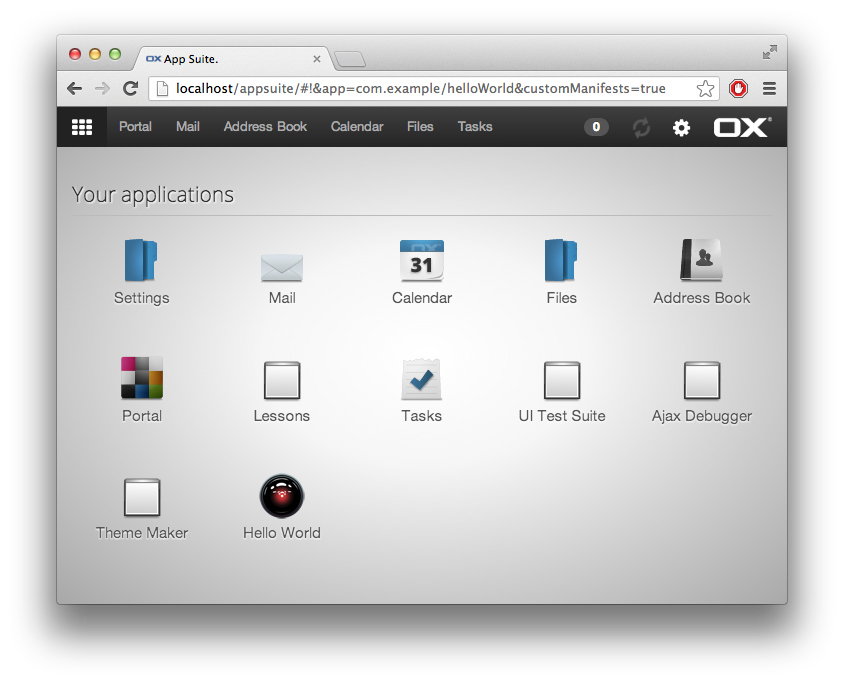
Simple application
This is the base skeleton of a new app with a window, that displays "Hello World". Please read the annotated source code of an example main.js below, it is quite self-explanatory.
define('com.example/helloWorld/main', [], function () {
'use strict';
// this is just code. loading this does not imply to launch the application
// application object. 'name' is mandatory!
var app = ox.ui.createApp({ name: 'com.example/helloWorld' });
// by using setLauncher this way, we register a callback function
// that is called when the application is really launched
app.setLauncher(function () {
// application window (some applications don't have a window)
var win = ox.ui.createWindow({
name: 'com.example/helloWorld',
title: 'Hello World'
});
app.setWindow(win);
// Add css class with your namespace
win.addClass('com-example-helloWorld');
// add something on 'main' node
win.nodes.main
.css({ padding: '13px', textAlign: 'center' })
.append($('<h1>').text('Hello World!'));
// show the window
win.show();
});
return {
getApp: app.getInstance
};
});
Save this file, build and refresh your browser, go to "Your applications", where you should find your app with your app icon. Hint: You can also launch the application manually via your browsers console:
ox.launch('com.example/helloWorld/main');
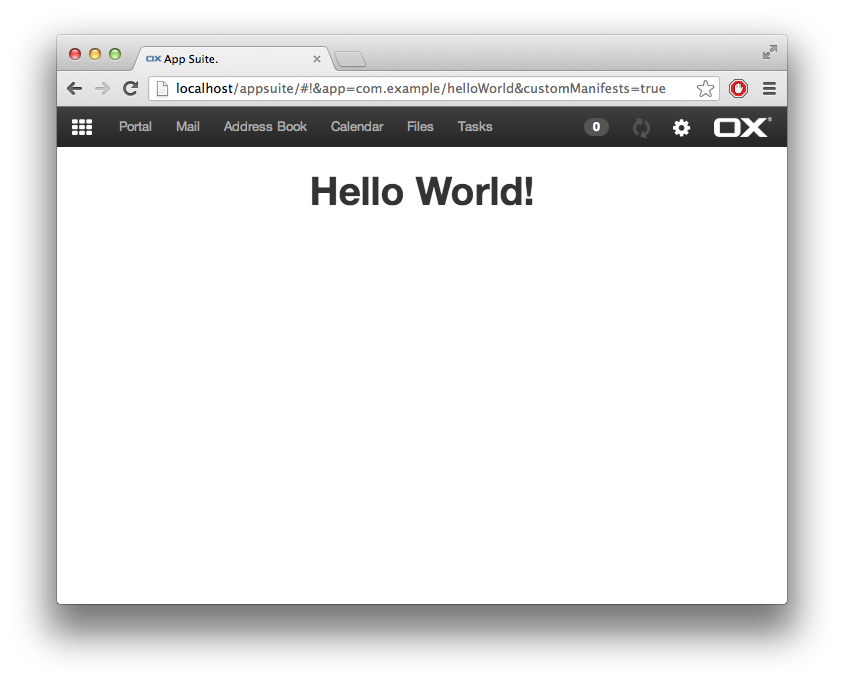
Styles
In order to prevent conflicts with other apps or base-styles you should add a css class with your namespace to the main node of your application.
win.addClass('com-example-helloWorld');
It is convention to create a file called style.less in the root folder of your application. This file has to be defined for require.js which is done like this.
define('com.example/helloWorld/main',
['less!com.example/helloWorld/style.less'
], function () {
//...
})
A simple less file would look like this:
.com-example-helloWorld {
h1 {
color: red;
}
...
}

Internationalization (i18n)
In order to get gettext support for your app you have to require it:
define('com.example/helloWorld/main',
['gettext!com.example/helloWorld'
], function (gt) {
//...
})
Every string in your app should be processed by gettext in order to have them properly translated. In our example it would look like this:
//...
.append($('<h1>').text(gt('Hello World!')));
//...
Hint: If you want to check your app for untranslated strings, append &debug-i18n=true to the URL in your browser and refresh. If a string is not processed by gettext it will be highlighted.
You can find more detailed information on this topic here.
Making an application window chromeless
If you don't have the need for a toolbar and want a chromeless window, you can it in the ox.ui.createWindow function call.
var win = ox.ui.createWindow({
//...
chromeless: true
//...
});
Creating a Dialog
In order to open a dialog io.ox/core/tk/dialogs has to be required and use one of the supplied methods.
win.nodes.main
.append($('<a class="btn">').text('Open Modal Dialog')
.on('click', function (e) {
e.preventDefault();
require(['io.ox/core/tk/dialogs'],
function (dialogs) {
new dialogs.ModalDialog({
width: 600,
easyOut: true
})
.append($('<p>').text('Hello world'))
.addButton('close', 'Close')
.show();
}
);
})
);
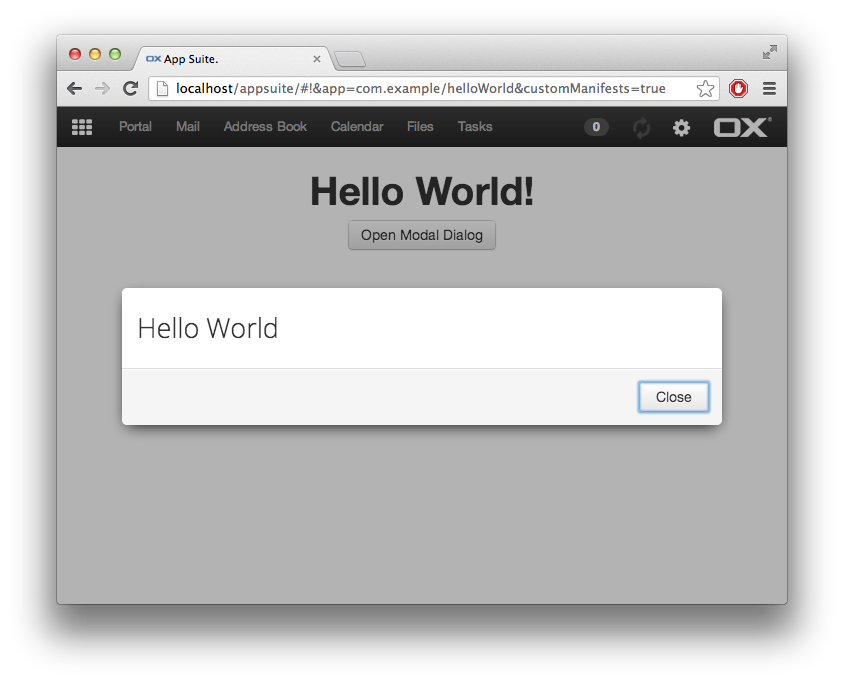
Displaying a notification
If you want to display notifications you can require _io.ox/core/notifications_and use the yell method, like in the examples below.
require(['io.ox/core/notifications'],
function (notifications) {
win.nodes.main
.append(
$('<a class="btn">').text('Display success notfication')
.on('click', function () {
notifications.yell('success', 'Ah success!');
}),
$('<a class="btn">').text('Display error notfication')
.on('click', function () {
notifications.yell('error', 'Oh failed!');
})
);
});
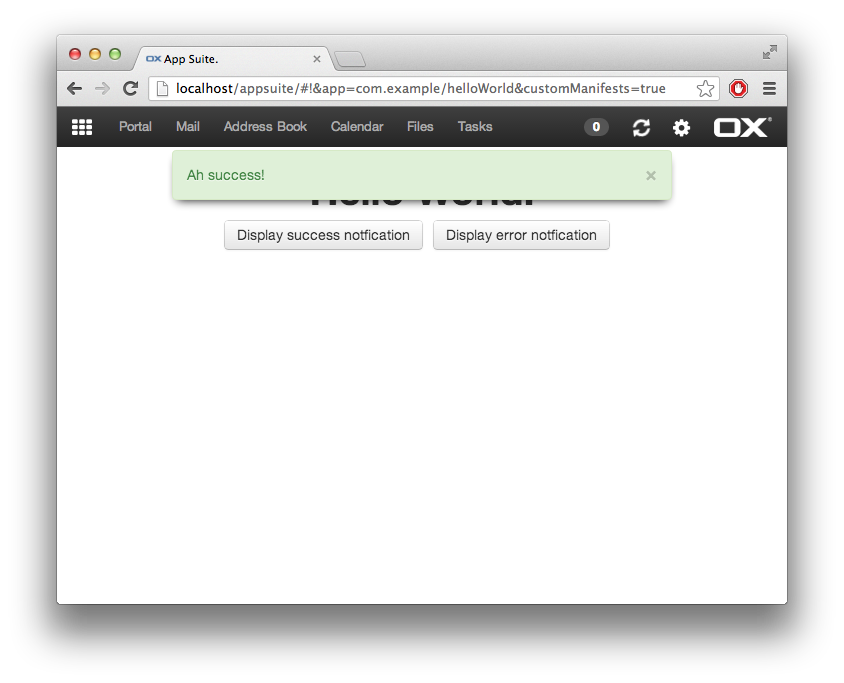
You can find information about more advanced notifications here.
Displaying a Halo View
For internal users
win.nodes.main.append(
$('<a href="#" class="btn halo-link">')
.data({ internal_userid: ox.user_id })
.text('Open Halo')
);
For external users
win.nodes.main.append(
$('<a class="btn halo-link">')
.data({ email1: 'test@example.com' })
.text('Open Halo from Email')
);
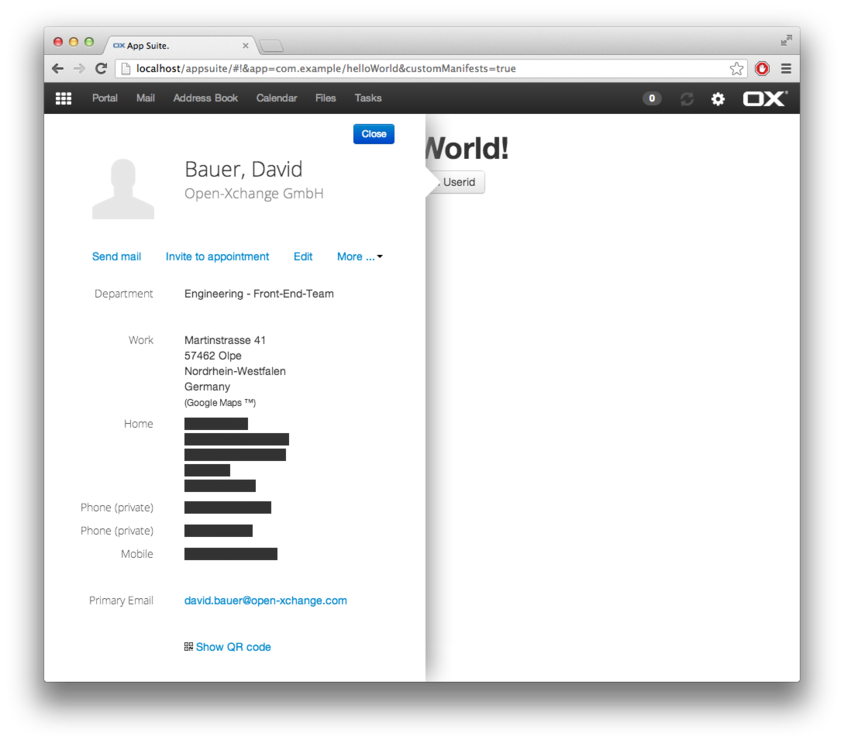
Using settings
To get or set settings you have to create a settings subfolder, with a defaults.js in which the default values are defined for your settings and a model.js. Below you will find a simple example of these files.
Defaults
define('com.example/helloWorld/settings/defaults', [], function () {
'use strict';
// define the default values for your settings here
var settingsDefaults = {
exampleSetting: false
};
return settingsDefaults;
});
Model
define('com.example/helloWorld/settings/model',
['settings!com.example/helloWorld'], function (settings) {
'use strict';
// Very simple default model
var helloWorldModel = Backbone.Model.extend({
initialize: function () {
},
save: function () {
settings.save(this.attributes);
},
destroy: function () {
}
});
return helloWorldModel;
});
Get/Set
require(['settings!com.example/helloWorld'],
function (settings) {
win.nodes.main
.append(
$('<label>').text(gt('Example Setting')),
$('<input type="checkbox">')
.prop('checked', settings.get('exampleSetting', false))
.on('change', function () {
settings.set('exampleSetting', $(this).prop('checked')).save();
})
);
});
Download full example
You can download the example application here with all above shown examples above included.
Hello World - Simple application full example.zip
Stuck somewhere?
You got stuck with a problem while developing? OXpedia might help you out with the article about debugging the UI.
